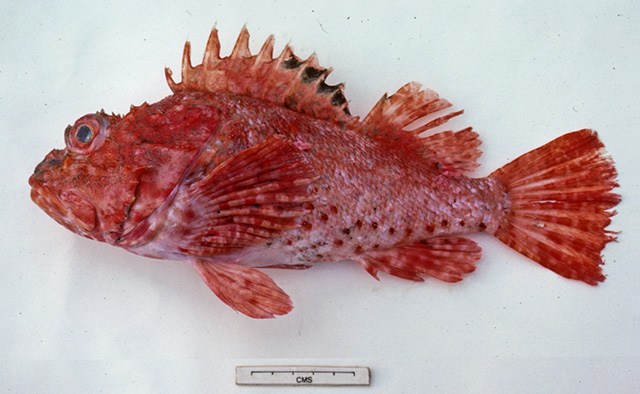| Scorpaenidae (Scorpionfishes or rockfishes), subfamily: Scorpaeninae |
| 33.65 cm SL (male/unsexed); max. reported age: 33 years |
|
reef-associated; marine |
| Western Pacific: coastal water of eastern Australia, from southern Queensland to Victoria. |
|
Dorsal soft rays (total): 9-9. This species is distinguished by the following set of characters: D 9, the 4th (rarely third) dorsal-fin spine longest; pectoral-fin rays 16-18 (mode 17); scale rows in longitudinal series 52-61(55); pored lateral-line scales 22-24 (23); scales above lateral line 4-6 (5), below 20-25 (22); scale rows between 6th dorsal-fin spine base and lateral line 6-8 (7), between last dorsal-fin spine base and lateral line 7-9 (9); pre-dorsal scale rows 1-4 (2); gill rakers on upper limb 4-6 (5), lower limb 10-13 (11) [7-9 and 2-5 rakers on ceratohyal and hypobranchial, respectively], total rakers 14-19 (16); embedded cycloid scales covering pectoral-fin base (some scales exposed); embedded cycloid scales on anteroventral surface of body (covered by thick skin, not visible without dissection); lateral surface of maxilla without a longitudinal ridge; lateral lacrimal spine with 2 (rarely 3) spinous points; anterior lacrimal spine with 1 or 2 small spinous points on its posterior margin; posterior lacrimal spine simple, directed anteroventrally in juveniles and young less than 100 mm SL, ventrally or posteroventrally in adults; median interorbital ridge present; interorbital and coronal spines absent; presence of occipital pit and supplement preopercular spine; pterotic spine usually simple in young, with 2 or more points in large adults usually more than 28.0 cm SL; space between upper and lower opercular spines covered by thick skin with sensory pores and canals; numerous skin flaps and tentacles on anterodorsal surface of body; a large black blotch distally on posterior spinous portion of dorsal fin in males; no distinct white blotches on caudal-fin base (Ref. 93606). |
| Common in rocky coastal reefs (Ref. 93630). |
|
Not Evaluated (N.E.) Ref. (130435)
|
| harmless |
|
Known from southern Queensland to Victoria (Ref. 93606). Also Ref. 7300. |
Source and more info: www.fishbase.org. For personal, classroom, and other internal use only. Not for publication.

